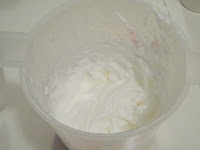Dictionary.com defines a lotion as "a liquid cosmetic, usually containing agents for soothing or softening the skin, especially that of the face or hands."
A lotion is an emulsified creation, meaning something that contains water, emollient(s), and an emulsifier used as a moisturizing product. That is to say that a lotion is anything that we consider an oil-in-water or water-in-oil product. A facial moisturizer so thin it pours like water and a body butter so thick you can't get it out of the container are both lotions. That cold cream your mom used to use - a water-in-oil creation - and that sunscreen you put on last weekend are both lotions. There isn't a hard and fast rule about what should be considered a body butter, facial moisturizer, hand lotion, and so on, except that they are all lotions.
We have our own definitions of what should be considered a body butter - something very thick that I have to scoop out of a jar - or a facial moisturizer - something I can squeeze out of a small bottle with a disc cap - but these are subjective ideas. And don't get me started on creams, cremes, or hydrators!
You're right about the butters thickening our products. The quickest way to make a pumpable lotion into a body butter is to substitute some of the oils for butters and the quickest way to turn a body butter into a pumpable lotion is to remove the butters, but butters aren't the only thickeners! For instance, I make a hand lotion with 60% water, 5% butters, and 13% oils that is easy to squeeze out of a malibu or tottle container.
But also consider your thickeners. What emulsifier are you using? What fatty alcohols - cetyl, cetearyl, behenyl - or fatty acids - stearic acid - or esters - cetyl esters - are you using in the formula? I can make a recipe with 10% butter that isn't very thick if I leave all the thickeners out, and I can make a recipe with no butters thicker by using stearic acid or cetyl alcohol. (Here's an example recipe in which I consider what each of these thickeners will bring to the party!)
Click here for more information about using butters in your lotions. Click here for more information about using fatty alcohols, acids, and esters in your lotions. If you want to know more about the different kinds of lotions we can make, click here! And if you want to learn more about making lotions, click here for the start of the learning to formulate series for lotions!
So to answer your question - a lotion can be any emulsified product and isn't necessarily something you can pour. You can reduce the viscosity of the lotion by decreasing the butters, increasing the water, or reducing the thickeners. (I go over all of these things in the learning to formulate series, hence the not-so-in-depth answer here!)












0 comments:
Post a Comment